microRNA | 09 Jun 2020
Why in News
Recently, researchers at the Indian Institute of Technology (IIT) Madras have identified a specific microRNA (miRNA) called ‘miR-155’ that is over-expressed in tongue cancer.
Key Points
- MicroRNAs:
- These are short non‐coding Ribonucleic Acids (RNAs) containing 20–24 nucleotides that participate in virtually all biological pathways in animals.
- They play important roles in many cancers, in carcinogenesis, malignant transformation and metastasis.
- Carcinogenesis: It is the formation of cancer (uncontrolled development of cells), whereby normal cells are transformed into cancer cells. It is also called oncogenesis or tumorigenesis.
- Malignant transformation: It is the process by which cells acquire the properties of cancer. This may occur as a primary process in normal tissue, or secondarily as malignant degeneration of a previously existing benign tumour.
- Metastasis: The spread of cancer cells from the place where they first formed to another part of the body. In metastasis, cancer cells break away from the original (primary) tumour, travel through the blood or lymph system and form a new tumour in other organs or tissues of the body.
- Oncomirs:
- The miRNAs associated with cancer are called Oncomirs.
- They affect cancer growth through inhibiting or enhancing the functions of certain proteins.
- Oncomirs affect cancer by suppressing the performance of tumour-suppressing agents which can prevent the growth and spread of cancer cells and sometimes prevent tumour growth itself.
- Significance of the Research:
- The finding could help develop molecular strategies to manipulate miR-155 expression to develop therapeutics for tongue cancer.
- miRNA manipulation is being combined with conventional cancer treatment methods such as chemotherapy, radiotherapy and immunotherapy.
- Eliminating miR-155 causes death of cancer cells, arrests the cell cycle and regresses tumour size in animal models and reduces cell viability and colony formation in benchtop (suitable for convenient use on a laboratory workbench) assays.
- An assay is an investigative (analytic) procedure in laboratory medicine, pharmacology, environmental biology and molecular biology for qualitatively assessing or quantitatively measuring the presence, amount, or functional activity of a target entity (the analyte).
Ribonucleic Acid
- RNA is a polymer of ribonucleotides and an important biological macromolecule that is present in all biological cells.
- It is principally involved in the synthesis of proteins, carrying the messenger instructions from Deoxyribonucleic acid (DNA), which itself contains the genetic instructions required for the development and maintenance of life.
- RNA differs from DNA in three basic respects:
- RNA employs uracil as a nitrogenous base, in place of the thymine used in DNA.
- RNA nucleotides possess a hydroxyl group at the 2nd position, while DNA is deoxygenated at that position to a proton.
- RNA is more often found single-stranded than DNA, which is typically completely base-paired into a double helix.

